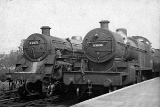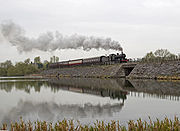
S&DJR 7F 2-8-0
Encyclopedia


Somerset and Dorset Joint Railway
The Somerset & Dorset Joint Railway – almost always referred to as "the S&D" – was an English railway line connecting Bath in north east Somerset and Bournemouth now in south east Dorset but then in Hampshire...
(S&DJR) 7F 2-8-0 is a class of steam locomotive
Steam locomotive
A steam locomotive is a railway locomotive that produces its power through a steam engine. These locomotives are fueled by burning some combustible material, usually coal, wood or oil, to produce steam in a boiler, which drives the steam engine...
designed for hauling heavy coal and goods trains. Eleven were built in two batches in 1914 and 1925, and were used until withdrawn between 1959 and 1964. Two are preserved.
Background
The Midland RailwayMidland Railway
The Midland Railway was a railway company in the United Kingdom from 1844 to 1922, when it became part of the London, Midland and Scottish Railway....
, joint owners of the S&DJR with the London and South Western Railway
London and South Western Railway
The London and South Western Railway was a railway company in England from 1838 to 1922. Its network extended from London to Plymouth via Salisbury and Exeter, with branches to Ilfracombe and Padstow and via Southampton to Bournemouth and Weymouth. It also had many routes connecting towns in...
, were in charge of locomotive policy on the line. The S&DJR which was highly graded and required power over and above what was available from the Midland's small engines. M. H. Ryan, S&DJR locomotive superintendent argued for a type specific to the line.
Two plans for 0-8-0
0-8-0
Under the Whyte notation for the classification of steam locomotives, 0-8-0 represents the wheel arrangement of no leading wheels, eight powered and coupled driving wheels on four axles, and no trailing wheels...
s were suggested in 1907 but would have been too heavy. Clearly a special exception to the small engine policy, James Clayton the draughtsman at Derby was given a free hand to design the engine, and produced something unlike any other Derby-designed locomotive of the time.
Design
The design used the G9AS boiler from the Midland CompoundsMidland Railway 1000 Class
Midland Railway 1000 Class is a class of 4-4-0 steam locomotive designed for passenger work.-Overview:These were developed from a series of five locomotives introduced in 1902 by Samuel W...
, with a Belpaire firebox
Belpaire firebox
The Belpaire firebox is a type of firebox used on steam locomotives. It was invented by Alfred Belpaire of Belgium. It has a greater surface area at the top of the firebox, improving heat transfer and steam production...
and Walschaerts valve gear. A leading pony truck
Pony truck
A pony truck, in railway terminology, is a leading truck with only two wheels.Its invention is generally credited to Levi Bissell, who devised one in 1857 and patented it the following year. Hence the term Bissel bogie or axle is used in continental Europe...
was added, to distribute the weight, making it a 2-8-0
2-8-0
Under the Whyte notation for the classification of steam locomotives, 2-8-0 represents the wheel arrangement of two leading wheels on one axle , eight powered and coupled driving wheels on four axles, and no trailing wheels...
. The cylinders were mounted high on the frame, and sloped, to avoid fouling platforms. Because of the gradients that the loco would face, Clayton provided two steam brake cylinders on the engine and a further one on the tender. The Derby standard axle boxes were fitted, so the engines were still subject to the hot boxes that were a fact of life on the Midland. As the locomotives were initially too large for some of the turntables, it was envisaged that they would spend half their time travelling in reverse. Consequently, they were fitted with tablet
Token (railway signalling)
In railway signalling, a token is a physical object which a locomotive driver is required to have or see before entering onto a particular section of single track. The token is clearly endorsed with the name of the section it belongs to...
exchanging apparatus on both sides of the locomotive. In addition, the first six were equipped with cab tenders, but these were later removed circa 1920.. The 1914-built locomotives were right-hand drive, while the 1925-built were left-hand drive. In all cases the vacuum brake ejector
Injector
ʎ̩An injector, ejector, steam ejector, steam injector, eductor-jet pump or thermocompressor is a pump-like device that uses the Venturi effect of a converging-diverging nozzle to convert the pressure energy of a motive fluid to velocity energy which creates a low pressure zone that dɯaws in and...
was located on the driver's
Railroad engineer
A railroad engineer, locomotive engineer, train operator, train driver or engine driver is a person who drives a train on a railroad...
side of the smokebox.
Construction
Six were built in 1914 and numbered 80–85 by the S&DJR. In 1925 an additional 5 were ordered from Robert Stephenson and CompanyRobert Stephenson and Company
Robert Stephenson and Company was a locomotive manufacturing company founded in 1823. It was the first company set up specifically to build railway engines.- Foundation and early success :...
in Darlington
Darlington
Darlington is a market town in the Borough of Darlington, part of the ceremonial county of County Durham, England. It lies on the small River Skerne, a tributary of the River Tees, not far from the main river. It is the main population centre in the borough, with a population of 97,838 as of 2001...
and built with the larger G9BS boilers, becoming numbers 86–90. Two locomotives, 9679 (ex-89) and 9680 (ex-90) received the smaller G9AS boiler in 1930, while the remaining three retained the larger boiler until it was replaced in the 1950s – 53808 in 1953; 53807 in 1954; and 53806 in 1955. These locomotives gained a packing piece between the smaller boiler and original smokebox saddle. The exception was 53807, whose smokebox saddle was rotten and was replaced with a one-piece unit like the 1914-built locomotives. This locomotive was therefore unique, as only left-hand drive locomotive with a one piece smokebox saddle.
East Midlands trials
Their success on the Mendip hillsMendip Hills
The Mendip Hills is a range of limestone hills to the south of Bristol and Bath in Somerset, England. Running east to west between Weston-super-Mare and Frome, the hills overlook the Somerset Levels to the south and the Avon Valley to the north...
prompted the Midland to try them on the East Midlands
East Midlands
The East Midlands is one of the regions of England, consisting of most of the eastern half of the traditional region of the Midlands. It encompasses the combined area of Nottinghamshire, Derbyshire, Leicestershire, Rutland, Northamptonshire and most of Lincolnshire...
coal trains, but they were not so satisfactory. They were, after all, designed for climbing hills, but perhaps the reasons were fuel efficiency, for they consumed considerable amounts of high quality coal.
Later life
The S&DJR locos were taken into London, Midland and Scottish RailwayLondon, Midland and Scottish Railway
The London Midland and Scottish Railway was a British railway company. It was formed on 1 January 1923 under the Railways Act of 1921, which required the grouping of over 120 separate railway companies into just four...
stock in 1930, and renumbered 9670–9680. They were renumbered as 13800–13810 in 1932. On nationalisation in 1948 British Rail
British Rail
British Railways , which from 1965 traded as British Rail, was the operator of most of the rail transport in Great Britain between 1948 and 1997. It was formed from the nationalisation of the "Big Four" British railway companies and lasted until the gradual privatisation of British Rail, in stages...
ways added 40000 to their numbers making them 53800–53810.
Withdrawals of the 1914-built locomotives occurred between 1959 and 1962 and the 1925-built engines between 1963 and 1964.
| Year | Quantity in service at start of year | Quantity withdrawn | Locomotive numbers |
|---|---|---|---|
| 1959 | 11 | 1 | 53800 |
| 1960 | 10 | 1 | 53802 |
| 1961 | 9 | 2 | 53801, 53805 |
| 1962 | 7 | 2 | 53803, 53804 |
| 1963 | 5 | 1 | 53810 |
| 1964 | 4 | 4 | 53806–53809 |
Preservation
Two have survived, 88 (9678/13808/53808) on the West Somerset RailwayWest Somerset Railway
The West Somerset Railway is a railway line that originally linked and in Somerset, England.It opened in 1862 and was extended from Watchet to by the Minehead Railway in 1874. Although just a single track, improvements were needed in the first half of the twentieth century to accommodate the...
and 89 (9679/13809/53809)at the Midland Railway - Butterley
Midland Railway - Butterley
The Midland Railway – Butterley is a heritage railway, formerly known until 2004 as the Midland Railway Centre, at Butterley, near Ripley in Derbyshire.-Overview:...
. No. 88 returned to service in December 2005 and is painted in S&DJR blue livery, which it never carried in service.
No. 89's latest overhaul was completed in January 2006, and the locomotive emerged in BR Black Livery as No. 53809 (with Late Crest), entering service in early February at the Midland Railway - Butterley
Midland Railway - Butterley
The Midland Railway – Butterley is a heritage railway, formerly known until 2004 as the Midland Railway Centre, at Butterley, near Ripley in Derbyshire.-Overview:...
.
Both met for the first time in preservation at the West Somerset Railway
West Somerset Railway
The West Somerset Railway is a railway line that originally linked and in Somerset, England.It opened in 1862 and was extended from Watchet to by the Minehead Railway in 1874. Although just a single track, improvements were needed in the first half of the twentieth century to accommodate the...
during the next month, after No. 89 made a return to Bath Green Park Station over March 5 and 6th 2006, 40 years after the S&D closed.

